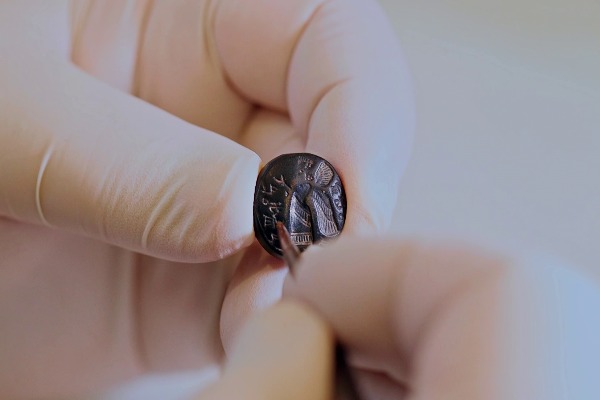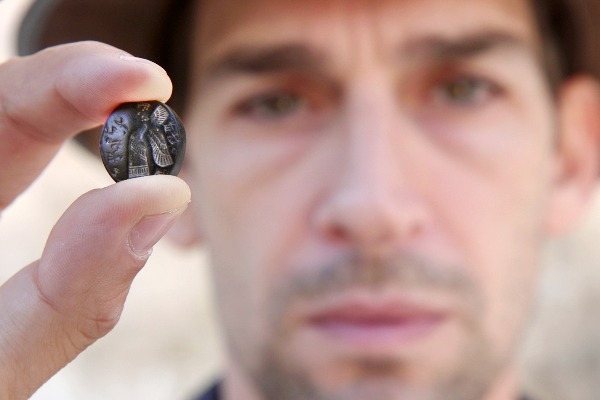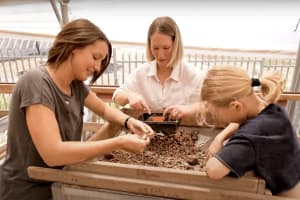'One of the most beautiful ever' - Ancient Judahite seal from First Temple era discovered in Jerusalem
Depiction of a winged demon is striking, given prohibition of figurative representations

A rare First Temple period seal, featuring a winged figure and a paleo-Hebrew inscription, was recently discovered near the Western Wall in Jerusalem. Described as "one of the most beautiful ever," the seal was most probably used by a senior Judahite official to sign documents.
The area of the Ophel and southern part of the temple retaining walls, a site of major archaeological significance, continues to reveal its secrets. It cnotains many artifacts bearing inscriptions, underscoring its role as a hub of high aristocracy and administration iduring the 8th to 6th centuries B.C.

This latest finding is a highly uncommon and distinctive stone seal from the First Temple era, dating back around 2,700 years. This artifact was discovered near the southern Wall of the Temple Mount in the Davidson Archaeological Garden. The excavation was conducted by the Israel Antiquities Authority (IAA) in partnership with the City of David Foundation.
Dr. Filip Vukosavović, an IAA archaeologist and assyriologist, analyzed the seal.
"This is an extremely rare and unusual discovery. This is the first time that a winged ‘genie’ – a protective magical figure – has been found in Israeli and regional archaeology. Figures of winged "demons" are known in the Neo-Assyrian art of the 9th-7th =Centuries B.C., and they were considered a kind of protective figure."
This artifact, crafted from black stone and engraved with a mirror image, served a dual purpose for its owner: As a protective amulet and a tool for officially marking documents and certificates. The seal features a convex cut on each side and a hole drilled through its length, allowing it to be worn on a chain around the neck. The central winged figure, possibly a monarch, is depicted in profile with wings, dressed in a long, striped garment, and moving towards the right.
The figure’s long curls flow down the neck, crowned with a hat or crown. One arm is extended forward with an open palm, possibly holding an object. On either side of the figure, an inscription in paleo-Hebrew reads: "LeYehoʼezer ben Hoshʼayahu."
The inscription, translated into English, reads: "Belongs to Yehoʼezer, son of Hoshʼayahu." These names are associated with individuals from the ancient Kingdom of Judah. The depiction of a winged, standing demon or figure is particularly striking, given the prohibition against figurative representations in ancient Israelite and Judean (and later Jewish) art.

Dr. Yuval Baruch, IAA excavation director and deputy director of Archaeology, emphasized the literacy of the period.
"This is further evidence of the reading and writing abilities that existed in this period. […] it seems that literacy in this period was not the realm only of society’s elite. People knew how to read and write […]. We know of many written seal impressions, in paleo-Hebrew script, from the environs of the City of David and the Kingdom of Judah."
Researchers theorize that the artifact, originally only displaying the image of the standing winged figure, was worn as a protective amulet by Hoshʼayahu, a man of considerable status in the Kingdom of Judah’s government. His authority and position likely influenced his decision to commission a seal featuring such a commanding figure.
"It seems that the object was made by a local craftsman – a Judahite, who produced the amulet at the owner’s request. It was prepared at a very high artistic level," Vukosavović added.
Upon Hoshʼayahu’s death (the father), it is believed that his son Yehoʼezer inherited the seal and subsequently added both his and his father's names on either side of the standing winged figure. This addition may have been an attempt to claim the protective attributes that the amulet was believed to possess.
Prof. Ronny Reich from the University of Haifa, a collaborator in this study, compares the craftsmanship of the seal, noted: Comparing the shape of the letters and the writing to those of other Hebrew seals and bullae (clay seal impressions) from Jerusalem shows that, in contrast to the careful engraving of the figure, inscribing the names on the seal was done in a sloppy manner. It is not impossible that perhaps it was Yehoʼezer himself who engraved the names on the object."
The significance of the seal is further enhanced by its biblical ties. The name Yehoʼezer (or Joezer) is mentioned in the Bible (Chronicles 1, 12:6) in an abbreviated form – Yoʼezer, one of King David's warriors. Additionally, a contemporary of the seal period, ʼAzariah ben Hoshʼaya (Azariah son of Hoshaiah), is referenced in the Book of Jeremiah 43:2.
His name contains the same components as the seal owner’s name, though in reverse order, with the second name appearing in an abbreviated form. This writing style corresponds with the name inscribed on the newly discovered seal, making it suitable for that era.
Baruch also highlighted the cultural influences reflected in the artifact.
"The figure of a winged man in a distinct Neo-Assyrian style is unique and very rare in the glyphic styles of the late First Temple period. The influence of the Assyrian Empire, which had conquered the entire region, is clearly evident."
Israeli Heritage Minister Rabbi Amichai Eliyahu expressed his excitement over the find, saying, “The spectacular and unique find […] opens another window for us into the days of the Kingdom of Judah during the First Temple period, and attests to that administration’s international connections. In doing so, it demonstrates the importance and centrality of Jerusalem already 2700 years ago […], a time in which the First Temple stood in all its glory.”
Prior excavations in areas near the Ophel, particularly those led by the late Dr. Eilat Mazar over the past several years, have uncovered other similarly remarkable inscribed artifacts, including what has been interpreted by many as the bullae (seal impression) of King Hezekiah and the Prophet Isaiah.
The excavations of Mazar have shown remains of a massive city gate at the Ophel area, where the king and prophet's bullae were discovered, dated to King Solomon's time during the 10th century B.C. through the destruction of the city by the Babylonians in 586 B.C.

There is no doubt thal this northern area of the city was a very important administrative center for the kingdom.
Archaeological evidence from recent years, especially from the City of David excavations and at the base of the Temple Mount, increasingly highlights the strength of the Kingdom of Judah during these biblical periods, but also the extent of Assyrian cultural influence in the region, particularly in Jerusalem.
This discovery, along with others in the Ophel area, further illustrates the complex interplay of local and foreign elements in shaping the identity of the city's elite, and provides critical insights into the political power and governance that characterized the northern area of the city of Jerusalem during the First Temple period, from King Solomon's time until 586 B.C.
Further details regarding this extraordinary stone seal in Jerusalem will be shared with the public during the 25th annual archaeological "City of David Research Conference," taking place on Wednesday, Sept. 4.

The All Israel News Staff is a team of journalists in Israel.
You might also like to read this:














